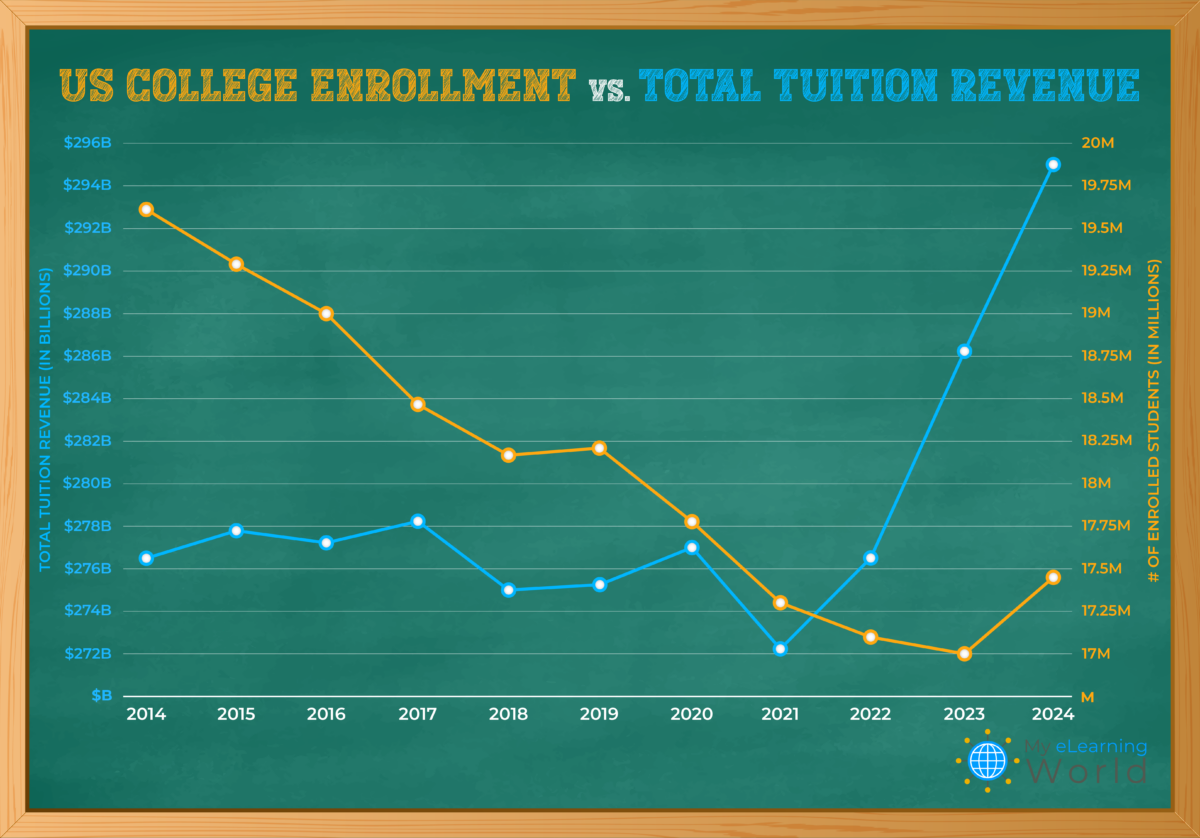College enrollment numbers have been declining for years, and the pandemic only accelerated the trend. And while colleges are experiencing the first minor increase in enrollment since the start of the pandemic, experts believe the overall trend of plummeting enrollment will continue thanks to ever-rising tuition rates and an upcoming significant drop in the number of college-aged Americans.
In fact, Fortune magazine pointed out that the decrease in the college-going rate since 2018 is the “steepest on record” according to the US Bureau of Labor Statistics.
With an estimated 2.16 million fewer students paying to go to college in the upcoming 2024 school year compared to 10 years ago, it would be natural to assume that colleges are facing a crisis. But what if we told you that despite plummeting student enrollment universities are still bringing in more total tuition revenue than at any time in history?
We’ve crunched the numbers and our analysis found that even though college enrollment has dropped by an astonishing 11% since 2014, colleges and universities are still bringing in 6.7% more in overall tuition revenue from students.
By the Numbers

According to data from the National Student Clearinghouse Research Center (NSCRC), in fall 2014, total enrollment across all two and four-year universities totaled 19.6 million students. Jump ahead a decade and our estimates for the fall 2024 semester show that number has dropped all the way to 17.45 million — a loss of nearly 2.2 million enrolled students in a 10-year span.
Here’s a look at total fall semester enrollment numbers over the last decade (includes enrollment at public two-year community colleges, public four-year universities, and private four-year universities):
- 19,619,773
- 19,280,473
- 19,010,459
- 18,482,391
- 18,163,525
- 18,239,874
- 17,778,484
- 17,302,364
- 17,112,038
- 17,026,478
- 17,452,140
With over 2 million fewer paying students, you’d think this decline would cause a pretty significant drop in revenue, but the exact opposite has happened.
We found that total annual revenue for US colleges from tuition and fees has increased by at least $18.4 billion over the last decade.
We determined this figure by examining student enrollment data from NSCRC over the past decade, covering community colleges, public universities, and private universities. Additionally, we analyzed the College Board’s historical tuition data for each sector by year.
By merging these two data sets and estimating Fall 2024 figures based on current data and recent trends, we were able to precisely determine how the enrollment decline affected total tuition revenue for colleges and universities.
- Community colleges–In 2014, two-year colleges had an average tuition of $3,630 for a full school year, pulling in $22 billion in revenue from 6.1 million enrolled students. In 2024, community college tuition has only increased a bit to an estimated $3,990 per year, for a total of $19.1 billion in tuition revenue (4.78 million students). What’s interesting is that two-year colleges are the only type of university to lose tuition revenue over the last decade.
- Public universities–In 2014, four-year public universities had an average in-state tuition of $9,950 for a full school year, pulling in at least $79.8 billion in revenue (likely higher as out-of-state tuition rates are higher, but data on enrollment numbers for in-state vs out-of-state was unavailable for the nearly 8 million total students). In 2024, public university tuition at four-year schools jumped to an estimated $11,260 per year, for a total of at least $87.8 billion in tuition revenue (7.8 million students).
- Private universities–In 2013, private universities had an average tuition of $34,020 for a full school year, pulling in $174.8 billion in revenue (5.14 million students). In 2024, tuition fees for four-year private universities increased to $41,540 per year according to our estimates, for a total of $188.1 billion in tuition revenue (4.53 million students).
US Colleges Lack Incentive to Lower Tuition
In most cases, if a business lost 11% of its customer base in large part because its product was too expensive, that business would likely do everything it could to lower prices to stop the trend. But that’s not at all what we’ve seen happen in higher education.
The cost of going to college has increased at more than 3x the rate of inflation over the last 40 years, causing many college-aged individuals to question if the ROI of higher education is worth it.
However, our analysis above shows that despite falling college enrollments, universities are generating higher revenues than ever before.
In other words, these institutions don’t really have an incentive at this point to make school more affordable for students.
- Elevating Your Virtual Presence: Why EMEET’s SmartCam S800 Stands Out in Modern Communication - 06/04/2025
- US Teachers Will Spend $3.35 Billion of Their Own Money on Classroom Expenses in 2025-25 School Year - 06/04/2025
- Report: Leveraging AI Tools Could Help US Teachers Avoid $43.4 Billion of Unpaid Overtime Work - 06/04/2025


